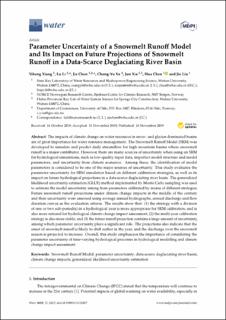| dc.description.abstract | The impacts of climate change on water resources in snow- and glacier-dominated basins are of great importance for water resource management. The Snowmelt Runoff Model (SRM) was developed to simulate and predict daily streamflow for high mountain basins where snowmelt runoff is a major contributor. However, there are many sources of uncertainty when using an SRM for hydrological simulations, such as low-quality input data, imperfect model structure and model parameters, and uncertainty from climate scenarios. Among these, the identification of model parameters is considered to be one of the major sources of uncertainty. This study evaluates the parameter uncertainty for SRM simulation based on different calibration strategies, as well as its impact on future hydrological projections in a data-scarce deglaciating river basin. The generalized likelihood uncertainty estimation (GLUE) method implemented by Monte Carlo sampling was used to estimate the model uncertainty arising from parameters calibrated by means of different strategies. Future snowmelt runoff projections under climate change impacts in the middle of the century and their uncertainty were assessed using average annual hydrographs, annual discharge and flow duration curves as the evaluation criteria. The results show that: (1) the strategy with a division of one or two sub-period(s) in a hydrological year is more appropriate for SRM calibration, and is also more rational for hydrological climate change impact assessment; (2) the multi-year calibration strategy is also more stable; and (3) the future runoff projection contains a large amount of uncertainty, among which parameter uncertainty plays a significant role. The projections also indicate that the onset of snowmelt runoff is likely to shift earlier in the year, and the discharge over the snowmelt season is projected to increase. Overall, this study emphasizes the importance of considering the parameter uncertainty of time-varying hydrological processes in hydrological modelling and climate change impact assessment | |

